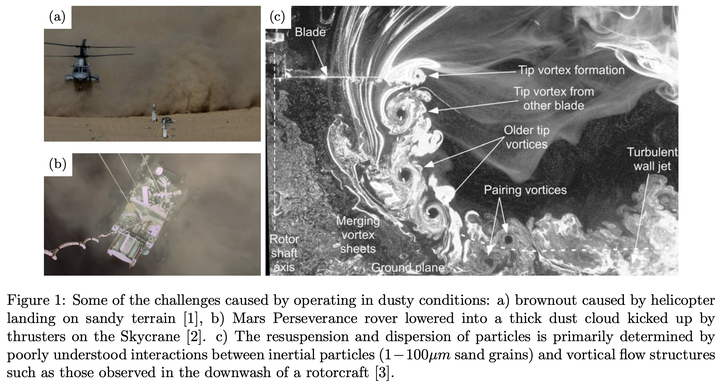Theoretical and numerical investigation of particle-vortex interaction in semi-dilute dusty flows

Funding: National Science Foundation, CBET - Particulate & Multiphase Flows award #2148710 (2022 – 2025).
Dusty flows are common in nature and engineering applications. Sand storms and volcanic ash are among examples wildly occurring in nature. In engineering applications, dusty flows may represent significant operating and safety challenges. Dust clouds kicked up by rotary aircrafts in ground proximity may reduce visibility, damage blades, and lead to engine degradation if ingested. Dust clouds kicked up by thrusters on planetary landing modules are known to interfere with on-board telemetry, create electrostatic hazard, and lead to uneven landing surfaces. Due to limited understanding of how the feedback force from micron-sized particles alters the carrier flow, predicting the evolution of semi-dilute dust clouds, such as those encountered in engineering, remains a formidably challenging task. The goal of this project is to reveal how particle feedback force modulates basic vortex dynamics that represent building blocks of general turbulent flows. The proposed work will enable predictive models of semi-dilute dust cloud, support the development of planetary landing modules, science missions relying on robotic helicopters to explore and collect soil samples, and the development of mitigation strategies for rotary aircrafts operating in desert conditions.
Related publications :
- A. V. S. Nath, A. Roy, and M. H. Kasbaoui, Instability of a dusty shear flow. Preprint at https://doi.org/10.48550/arXiv.2405.05539 (2024).
- S. Shuai, A. Roy, and M. H. Kasbaoui, The Merger of Co-Rotating Vortices in Dusty Flows, J. Fluid Mech. 981, A27 (2024).
- S. Shuai, D. J. Dhas, A. Roy, and M. H. Kasbaoui, Instability of a Dusty Vortex, Journal of Fluid Mechanics 948, A56 (2022).
- S. Shuai and M. H. Kasbaoui, Accelerated Decay of a Lamb–Oseen Vortex Tube Laden with Inertial Particles in Eulerian–Lagrangian Simulations, Journal of Fluid Mechanics 936, (2022).